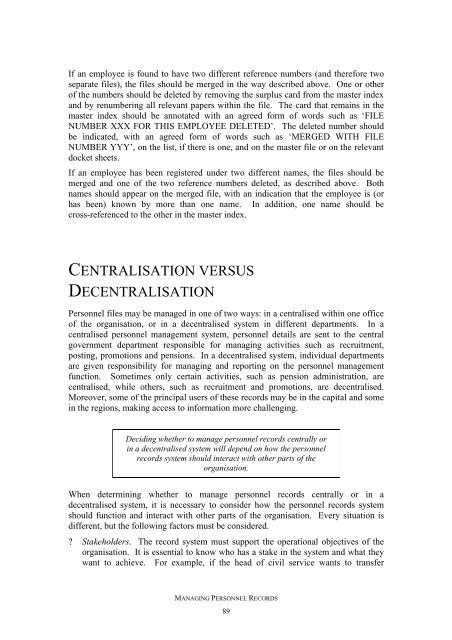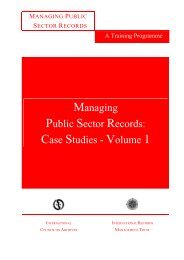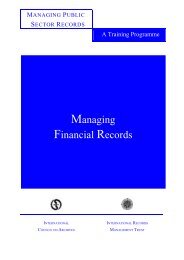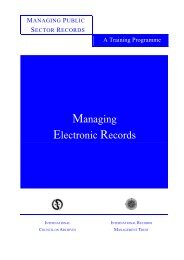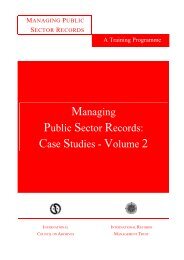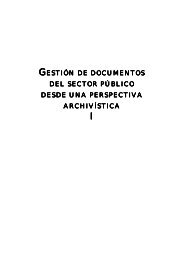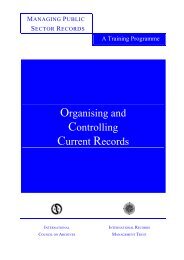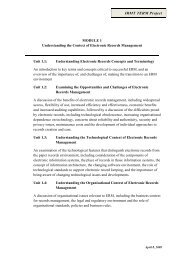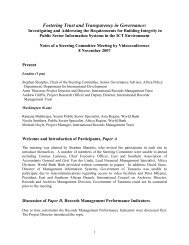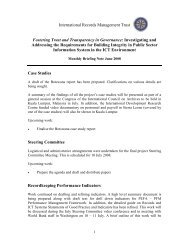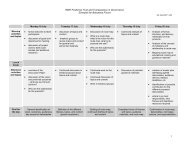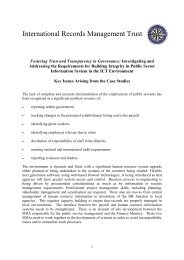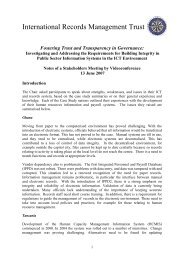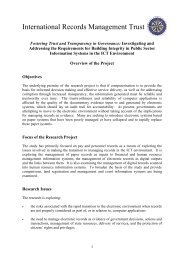Managing Personnel Records - International Records Management ...
Managing Personnel Records - International Records Management ...
Managing Personnel Records - International Records Management ...
Create successful ePaper yourself
Turn your PDF publications into a flip-book with our unique Google optimized e-Paper software.
If an employee is found to have two different reference numbers (and therefore two<br />
separate files), the files should be merged in the way described above. One or other<br />
of the numbers should be deleted by removing the surplus card from the master index<br />
and by renumbering all relevant papers within the file. The card that remains in the<br />
master index should be annotated with an agreed form of words such as ‘FILE<br />
NUMBER XXX FOR THIS EMPLOYEE DELETED’. The deleted number should<br />
be indicated, with an agreed form of words such as ‘MERGED WITH FILE<br />
NUMBER YYY’, on the list, if there is one, and on the master file or on the relevant<br />
docket sheets.<br />
If an employee has been registered under two different names, the files should be<br />
merged and one of the two reference numbers deleted, as described above. Both<br />
names should appear on the merged file, with an indication that the employee is (or<br />
has been) known by more than one name. In addition, one name should be<br />
cross-referenced to the other in the master index.<br />
CENTRALISATION VERSUS<br />
DECENTRALISATION<br />
<strong>Personnel</strong> files may be managed in one of two ways: in a centralised within one office<br />
of the organisation, or in a decentralised system in different departments. In a<br />
centralised personnel management system, personnel details are sent to the central<br />
government department responsible for managing activities such as recruitment,<br />
posting, promotions and pensions. In a decentralised system, individual departments<br />
are given responsibility for managing and reporting on the personnel management<br />
function. Sometimes only certain activities, such as pension administration, are<br />
centralised, while others, such as recruitment and promotions, are decentralised.<br />
Moreover, some of the principal users of these records may be in the capital and some<br />
in the regions, making access to information more challenging.<br />
Deciding whether to manage personnel records centrally or<br />
in a decentralised system will depend on how the personnel<br />
records system should interact with other parts of the<br />
organisation.<br />
When determining whether to manage personnel records centrally or in a<br />
decentralised system, it is necessary to consider how the personnel records system<br />
should function and interact with other parts of the organisation. Every situation is<br />
different, but the following factors must be considered.<br />
? Stakeholders. The record system must support the operational objectives of the<br />
organisation. It is essential to know who has a stake in the system and what they<br />
want to achieve. For example, if the head of civil service wants to transfer<br />
MANAGING PERSONNEL RECORDS<br />
89


